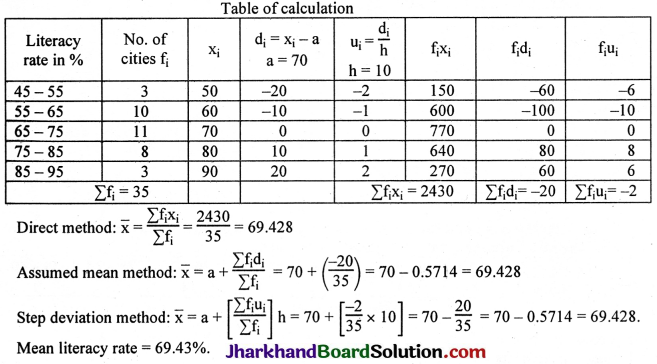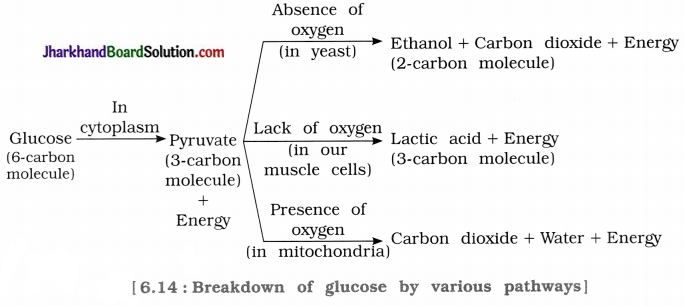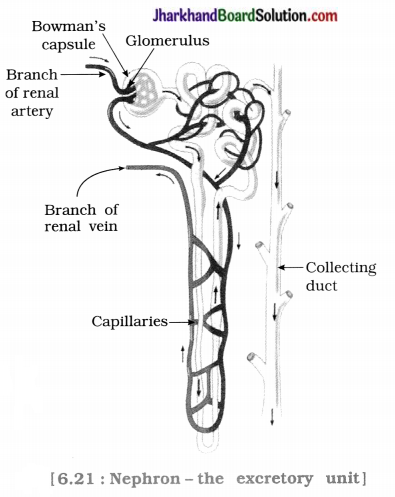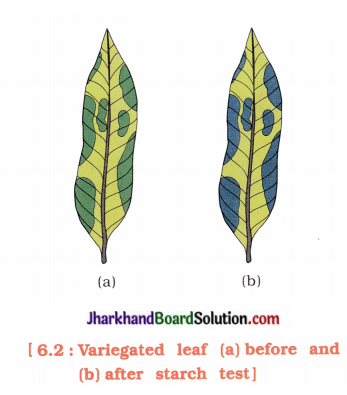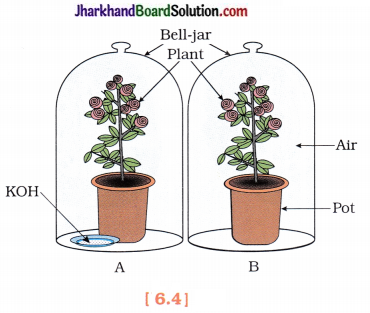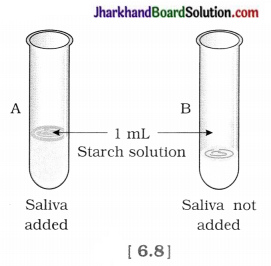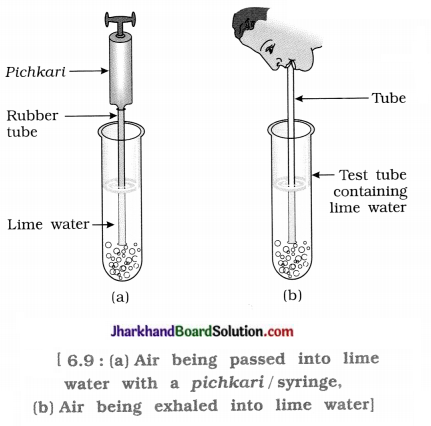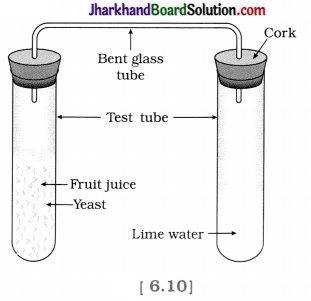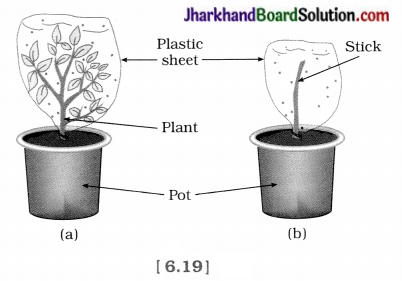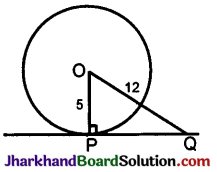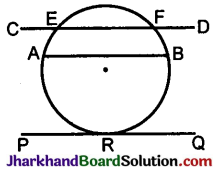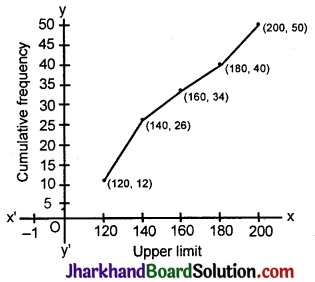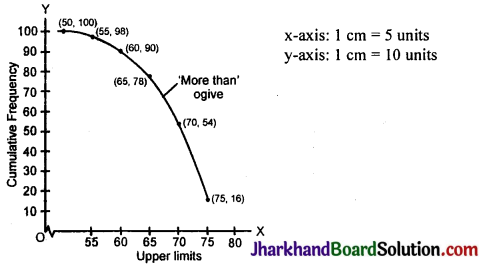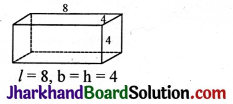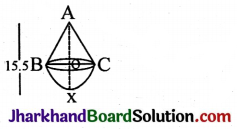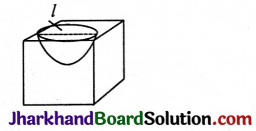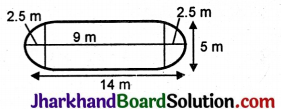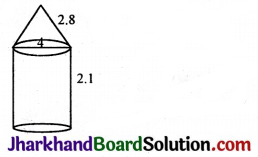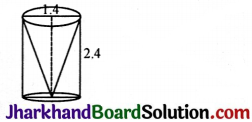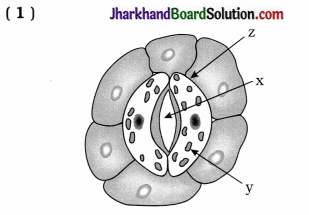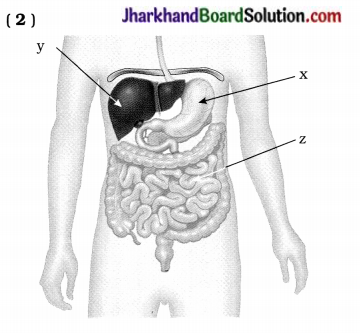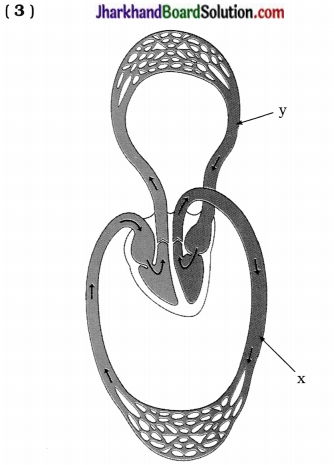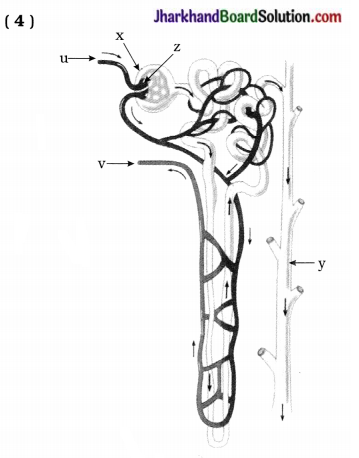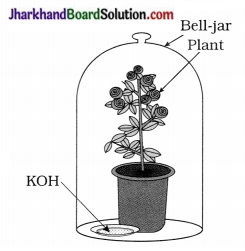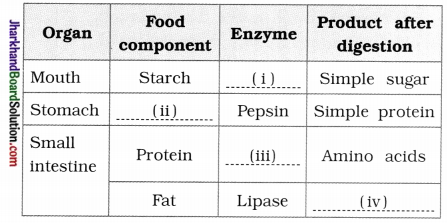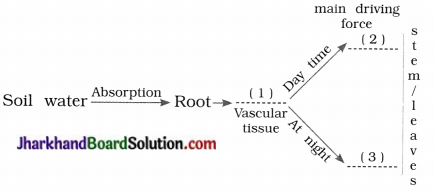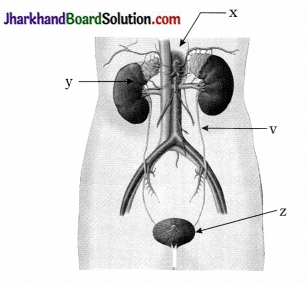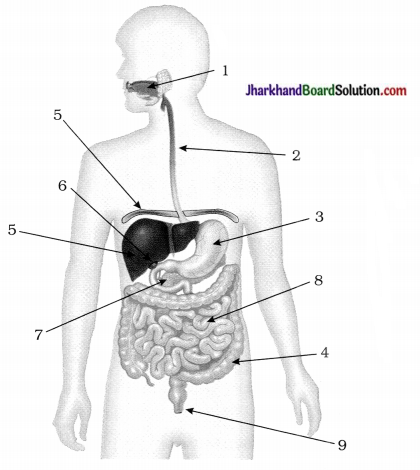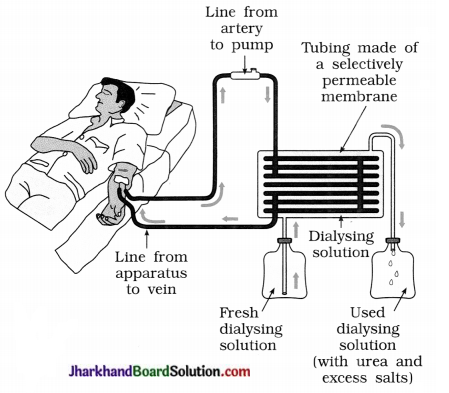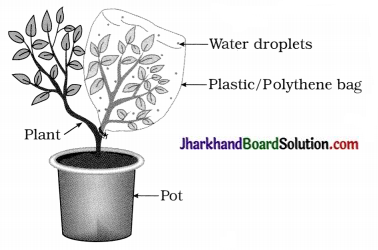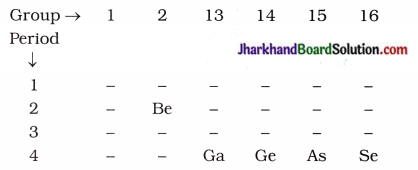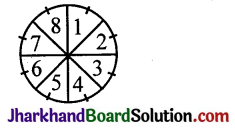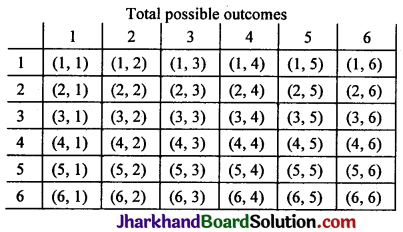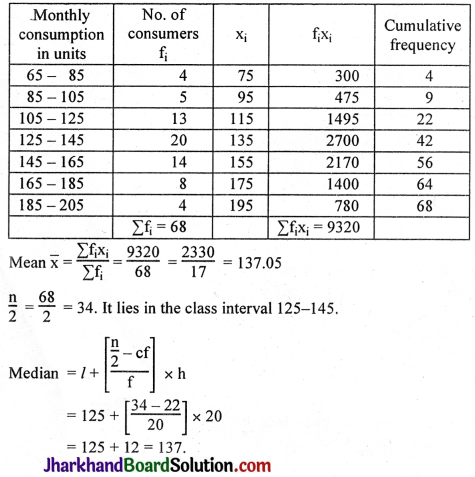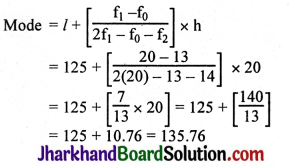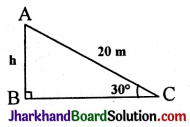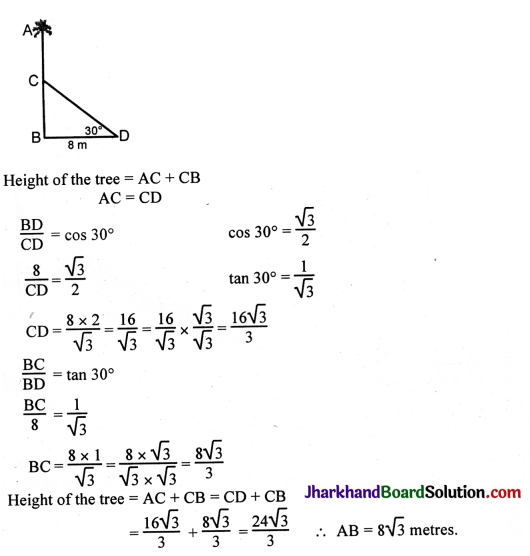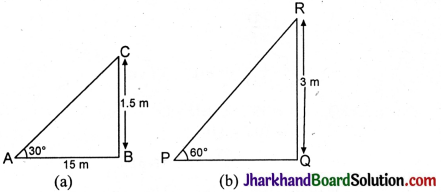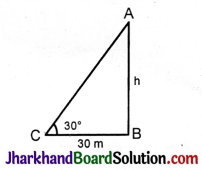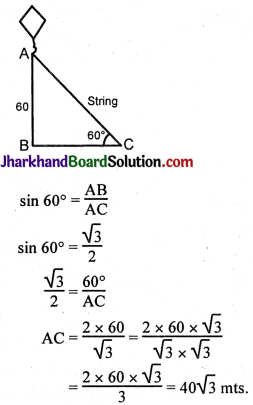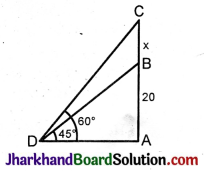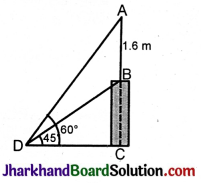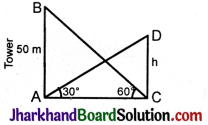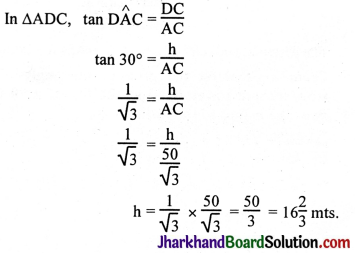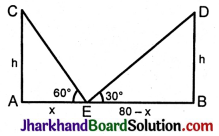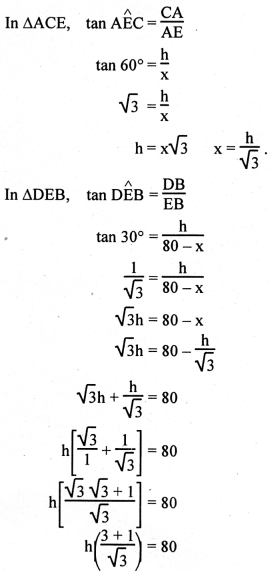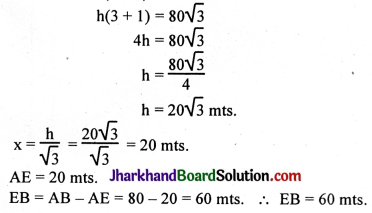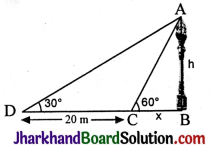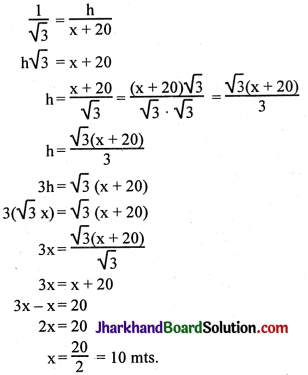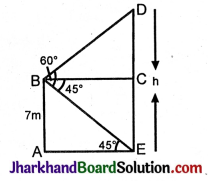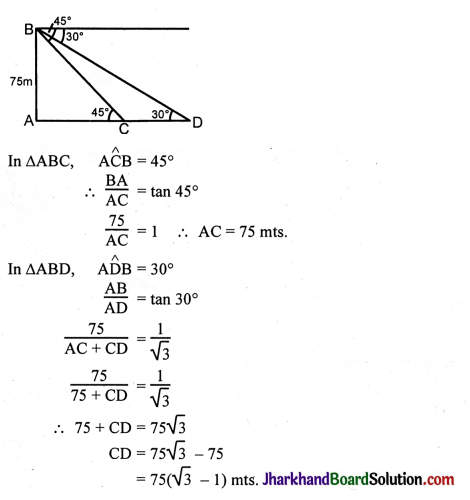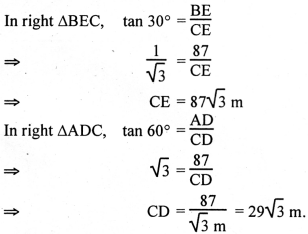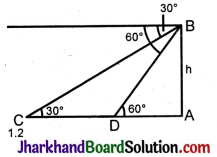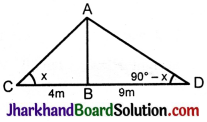Jharkhand Board JAC Class 10 Sanskrit Solutions Shemushi Chapter 1 शुचिपर्यावरणम् Textbook Exercise Questions and Answers.
JAC Board Class 10th Sanskrit Solutions Shemushi Chapter 1 शुचिपर्यावरणम्
JAC Class 10th Sanskrit शुचिपर्यावरणम् Textbook Questions and Answers
प्रश्न 1.
एकपदेन उत्तरं लिखत। (एक शब्द में उत्तर लिखिए।)
(क) अत्र जीवितं कीदृशं जातम्? (यहाँ जीवन कैसा हो गया है?)
(ख) अनिशं महानगरमध्ये किं प्रचलति? (दिन-रात महानगर में क्या चलता है?)
(ग) कुत्सितवस्तुमिश्रितं किमस्ति? (खराब वस्तु मिलावट वाला क्या है?)।
(घ) अहं कस्मै जीवनं कामये? (मैं किसके लिये जीवन की कामना करता हूँ?)
(ङ) केषां माला रमणीया? (किसकी माला सुन्दर है?)
उत्तरम् :
(क) दुर्वहम् (दूभर)।
(ख) कालायसचक्रम् (लोहे का पहिया)।
(ग) भक्ष्यम् (भोजन)।
(घ) मानवाय (मनुष्य के लिये)।
(ङ) हरिततरूणां ललितलतानाम् (हरे वृक्षों और सुन्दर बेलों की।)

प्रश्न 2.
अधोलिखितानां प्रश्नानाम् उत्तराणि संस्कृतभाषया लिखत (निम्नलिखित प्रश्नों के उत्तर संस्कृत भाषा में लिखिए)
(क) कविः किमर्थं प्रकृतेः शरणम् इच्छति ?
(कवि किसलिए प्रकृति की शरण चाहता है ?)
उत्तरम् :
कवि महानगरस्य दुर्वहं जीवनं दृष्ट्वा तस्मात् भीत: शुद्धपर्यावरणाय प्रकृतेः शरणम् इच्छति।
(कवि महानगर के दुष्कर जीवन को देखकर उससे डरा हुआ शुद्ध पर्यावरण के लिए प्रकृति की शरण में जाना चाहता है।)।
(ख) कस्मात् कारणात् महानगरेषु संसरणं कठिनं वर्तते ?
(किस कारण से महानगरों में विचरण कठिन हो गया है ?)
उत्तरम् :
अहर्निशं लौहचक्रस्य सञ्चरणात् यानानां बाहुल्यात् च महानगरेषु संसरणं कठिनं वर्तते।
(दिन-रात लौहचक्र के घूमने से तथा वाहनों की बहुलता के कारण महानगरों में चलना कठिन है।)
(ग) अस्माकं पर्यावरणे किं किं दूषितम् अस्ति ?
(हमारे पर्यावरण में क्या क्या दूषित है ?)
उत्तरम् :
अस्माकं पर्यावरणे वायुमण्डलं, जलं, भक्ष्यं, धरातलं च दूषितम् अस्ति।
(हमारे पर्यावरण में वायुमण्डल, जल, खाद्य पदार्थ और पृथ्वी दूषित हैं।)

(घ) कविः कुत्र संचरणं कर्तुम् इच्छति ?
(कवि कहाँ विचरण (भ्रमण) करना चाहता है ?)
उत्तरम् :
कविः ग्रामान्ते एकान्ते कान्तारे सञ्चरणं कर्तुम् इच्छति।
(कवि गाँव के बाहर एकान्त वन में भ्रमण करना चाहता है।)
(ङ) स्वस्थजीवनाय कीदृशे वातावरणे भ्रमणीयम् ?
(स्वस्थ जीवन के लिए कैसे वातावरण में घूमना चाहिए ?)
उत्तरम् :
स्वस्थजीवनाय शुचि-वातावरणे (पर्यावरणे) भ्रमणीयम्।
(स्वस्थ जीवन के लिए शुद्ध वातावरण में घूमना चाहिए।)
(च) अन्तिमे पद्यांशे कवेः का कामना अस्ति ?
(अन्तिम पद्यांश में कवि की कामना क्या है ?)
उत्तरम् :
अन्तिमे पद्यांशे कवेः कामना अस्ति यत् निसर्गे पाषाणी सभ्यता समाविष्टा न स्यात्।।
(अन्तिम पद्यांश में कवि की कामना है कि प्रकृति में पाषाण युग की सभ्यता का समावेश न हो।)
प्रश्न 3.
सन्धिं/सन्धिविच्छेदं कुरुत –
(सन्धि/सन्धिविच्छेद कीजिए)
(क) प्रकृतिः + …………… = प्रकृतिरेव।
(ख) स्यात् + …….. + …………….. = स्यान्नैव।
(ग) …….. + अनन्ताः = ह्यनन्ताः।
(घ) बहिः + अन्तः + जगति = ……..।
(ङ) …….. + नगरात् = अस्मान्नगरात्।
(च) सम् + चरणम् = ……..।
(छ) धूमम् + मुञ्चति = ……..।
उत्तरम् :
(क) प्रकृतिः + एव = प्रकृतिरेव।
(ख) स्यात् + न + एव = स्यान्नैव।
(ग) हि + अनन्ताः = ह्यनन्ताः।
(घ) बहिः + अन्तः + जगति = बहिरन्तर्जगति।
(ङ) अस्मात् + नगरात् = अस्मान्नगरात्।
(च) सम् + चरणम् = सञ्चरणम्।
(छ) धूमम् + मुञ्चति = धूमं मुञ्चति।
प्रश्न 4.
अधोलिखितानाम् अव्ययानां सहायतया रिक्तस्थानानि पूरयत –
(निम्नलिखित अव्ययों की सहायता से रिक्त स्थानों की पूर्ति कीजिए)
भृशम्, यत्र, तत्र, अत्र, अपि, एव, सदा, बहिः
(क) इदानी वायुमण्डलं ………….. प्रदूषितमस्ति।
(ख) ………… जीवनं दुर्वहम् अस्ति।
(ग) प्राकृतिक वातावरणे क्षणं सञ्चरणम् …….. लाभदायकं भवति।
(घ) पर्यावरणस्य संरक्षणम् ………. प्रकृतेः आराधना।
(ङ) ………. समयस्य सदुपयोगः करणीयः।
(च) भूकम्पित-समये ………….. गमनमेव उचितं भवति।
(छ) ……………… हरीतिमा …………. शुचि पर्यावरणम्।
उत्तरम् :
(क) इदानी वायुमण्डलं भृशं प्रदूषितमस्ति। (अब वायुमण्डल अत्यधिक प्रदूषित है।)
(ख) अत्र जीवनं दुर्वहम् अस्ति। (यहाँ जीवन दूभर है।)
(ग) प्राकृतिकवातावरणे क्षणं सञ्चरणम् अपि लाभदायकं भवति। (प्राकृतिक वातावरण में क्षणभर घूमना भी लाभदायक होता है।)
(घ) पर्यावरणस्य संरक्षणम् एव प्रकृते: आराधना। (पर्यावरण का संरक्षण ही प्रकृति की आराधना है।)
(ङ) सदा समयस्य सदुपयोगः करणीयः। (सदा समय का सदुपयोग करना चाहिए।)
(च) भूकम्पित-समये बहिः गमनमेव उचितं भवति। (भूकम्प के समय में बाहर जाना ही उचित है।)
(छ) यत्र हरीतिमा तत्र शुचि पर्यावरणम्। (जहाँ हरियाली है वहाँ शुद्ध पर्यावरण है।)

प्रश्न 5.
(अ) अधोलिखितानां पदानां पर्यायपदं लिखत –
(निम्नलिखित शब्दों के पर्याय शब्द लिखिए)
(क) सलिलम्
(ख) आम्रम्
(ग) वनम्
(घ) शारीरम्
(ङ) कुटिलम्
(च) पाषाणम्।
उत्तरम् :
(क) सलिलम् = जलम्
(ख) आम्रम् = रसालम्
(ग) वनम् = काननम् (कान्तारम्)
(घ) शरीरम् = तनुः (देहम्)
(ङ) कुटिलम् = वक्रम्
(च) पाषाणाम् = प्रस्तरम्।
(आ) अधोलिखितापदानां विलोमपदानि पाठात् चित्वा लिखत।
(निम्नलिखित पदों के विलोम पद पाठ से चुनकर लिखिये।)
पद – विलोमपद
(क) सुकरम् – दुष्करम्
(ख) दूषितम् – शुचि
(ग) गृह्णन्ती – वितरन्ती
(घ) निर्मलम् – समलम्
(ङ) दानवाय – मानवाय
(च) सान्ताः – अनन्ताः
प्रश्न 6.
उदाहरणमनुसृत्य पाठत् चित्वा समस्तपदानि समासनाम च लिखत –
(उदाहरण के अनुसार पाठ से चुनकर समस्त पद तथा समास का नाम लिखिए)
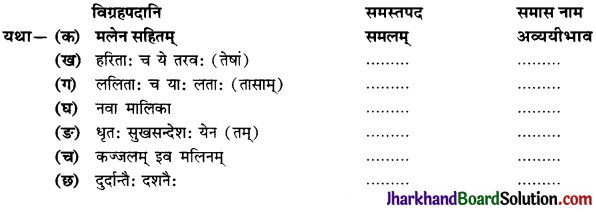
उत्तरम् :
(ख) हरिततरूणाम् (कर्मधारय)
(ग) ललितलतानाम् (कर्मधारय)
(घ) नवमालिका (कर्मधारय)
(ङ) धृतसुखसन्देशम् (बहुव्रीहि)
(च) कज्जलमलिनम् (कर्मधारय)
(छ) दुर्दान्तदशनैः (कर्मधारय)।

प्रश्न 7.
रेखाङ्कितपदमाधृत्य प्रश्ननिर्माणं कुरुत –
(रेखांकित शब्द के आधार पर प्रश्न बनाइए)
(क) शकटीयानम् कज्जलमलिनं धूमं मुञ्चति।
(मोटरगाड़ी काजल की तरह मलिन धुआँ छोड़ती है।)
(ख) उद्याने पक्षिणां कलरवं चेतः प्रसादयति।
(उद्यान में पक्षियों का कलरव चित्त को प्रसन्न करता है।)
(ग) पाषाणीसभ्यतायां लतातरुगुल्माः प्रस्तरतले पिष्टाः सन्ति।
(पाषाणकालीन सभ्यता में बेल, वक्ष, झाडियाँ पत्थरों के नीचे पिसी हैं।)
(घ) महानगरेषु वाहनानाम् अनन्ताः पङ्क्तयः धावन्ति।
(महानगरों में वाहनों की असीम पंक्तियाँ दौड़ती हैं।)
(ङ) प्रकृत्याः सन्निधौ वास्तविकं सुखं विद्यते।
(प्रकृति के सामीप्य में वास्तविक सुख है।)
उत्तरम् :
(क) शकटीयानं कीदृशं धूमं मुञ्चति ?
(मोटरगाड़ी कैसा धुआँ छोड़ती है ?)
(ख) उद्याने केषां कलरवं चेतः प्रसादयति ?
(उद्यान में किनका कलरव चित्त को प्रसन्न करता है?)
(ग) पाषाणीसभ्यतायां के प्रस्तरतले पिष्टाः सन्ति ?
(पाषाणकालीन सभ्यता में कौन पत्थर के नीचे पिसे हैं?)
(घ) कुत्र वाहनानाम् अनन्ताः पङ्क्तयः धावन्ति ?
(कहाँ वाहनों की असीम पंक्तियाँ दौड़ती हैं ?)
(ङ) कस्याः सन्निधौ वास्तविकं सुखं विद्यते ?
(किसके सामीप्य में वास्तविक सुख है ?)
योग्यताविस्तार :
समास – समसनं समासः
समास का शाब्दिक अर्थ होता है – संक्षेप। दो या दो से अधिक शब्दों के मिलने से जो नया और संक्षिप्त रूप बनता है, वह समास कहलाता है। समास के मुख्यतः चार भेद हैं –
1. अव्ययीभाव
2. तत्पुरुष
3. बहुव्रीहि
4. द्वन्द्व
1. अव्ययीभाव –
इस समास में पहला पद अव्यय होता है और वही प्रधान होता है और समस्तपद अव्यय बन जाता है।
यथा – निर्मक्षिकम्-मक्षिकाणाम् अभावः।
यहाँ प्रथमपद निर् है और द्वितीयपद मक्षिकम् है। यहाँ मक्षिका की प्रधानता न होकर मक्षिका का अभाव प्रधान है, अतः यहाँ अव्ययीभाव समास है। कुछ अन्य उदाहरण देखें –
- उपग्रामम् – ग्रामस्य समीपे – (समीपता की प्रधानता)
- निर्जनम् – जनानाम् अभावः – (अभाव की प्रधानता)
- अनुरथम् – रथस्य पश्चात् – (पश्चात् की प्रधानता)
- प्रतिगृहम् – गृहं गृहं प्रति – (प्रत्येक की प्रधानता)
- यथाशक्ति – शक्तिम् अनतिक्रम्य – (सीमा की प्रधानता)
- सचक्रम् – चक्रेण सहितम् – (सहित की प्रधानता)

2. तत्पुरुष –
‘प्रायेण उत्तरपदार्थप्रधानः तत्पुरुषः’ इस समास में प्रायः उत्तरपद की प्रधानता होती है और पूर्व पद उत्तरपद के विशेषण का कार्य करता है। समस्तपद में पूर्वपद की विभक्ति का लोप हो जाता है।
यथा – राजपुरुषः अर्थात् राजा का पुरुष। यहाँ राजा की प्रधानता न होकर पुरुष की प्रधानता है।
- ग्रामगतः – ग्रामं गतः।
- शरणागतः – शरणम् आगतः।
- देशभक्तः, – देशस्य भक्तः।
- सिंहभीतः – सिंहात् भीतः।
- भयापनः – भयम् आपन्नः।
- हरित्रातः – हरिणा त्रातः। तत्पुरुष समास के दो प्रमुख भेद हैं-कर्मधारय और द्विगु।
(ii) कर्मधारय – इस समास में एक पद विशेष्य तथा दूसरा पद पहले पद का विशेषण होता है। विशेषण विशेष्य भाव के अतिरिक्त उपमान उपमेय भाव भी कर्मधारय समास का लक्षण है।
यथा – पीताम्बरम् – पीतं च तत् अम्बरम्।
महापुरुषः – महान् च असौ पुरुषः।
कज्जलमलिनम् – कज्जलम् इव मलिनम्।
नीलकमलम् – नीलं च तत् कमलम्।
मीननयनम् – मीन इव नयनम्।
मुखकमलम् – कमलम् इव मुखम्।
(ii) द्विगु- ‘संख्यापूर्वो द्विगुः’ इस समास में पहला पद संख्यावाची होता है और समाहार (एकत्रीकरण या समूह) अर्थ की प्रधानता होती है।
यथा – त्रिभुजम् – त्रयाणां भुजानां समाहारः। इसमें पूर्वपद ‘त्रि’ संख्यावाची है।
पंचपात्रम् – पंचानां पात्राणां समाहारः।
पंचवटी – पंचानां वटानां समाहारः।
सप्तर्षिः . – सप्तानां ऋषीणां समाहारः।
चतुर्युगम् – चतुर्णा युगानां समाहारः।

3. बहुव्रीहि –
‘अन्यपदार्थप्रधानः बहुब्रीहिः’ इस समास में पूर्व तथा उत्तर पदों की प्रधानता न होकर किसी अन्य पद की प्रधानता होती है।
यथा –
पीताम्बरः – पीतम् अम्बरम् यस्य सः (विष्णुः)। यहाँ न तो पीतम् शब्द की प्रधानता है और न अम्बरम्
शब्द की अपितु पीताम्बरधारी किसी अन्य व्यक्ति (विष्णु) की प्रधानता है।
नीलकण्ठः – नीलः कण्ठः यस्य सः (शिवः)।
दशाननः – दश आननानि यस्य सः (रावण:)।
अनेककोटिसारः – अनेककोटिः सारः (धनम्) यस्य सः।
विगलितसमृद्धिम् – विगलिता समृद्धिः यस्य तम् (पुरुषम्)।
प्रक्षालितपादम् – प्रक्षालितौ पादौ यस्य तम् (जनम्)।
4. द्वन्द्व –
‘उभयपदार्थप्रधानः द्वन्द्वः’ इस समास में पूर्वपद और उत्तरपद दोनों की समान रूप से प्रधानता होती है। पदों के बीच में ‘च’ का प्रयोग विग्रह में होता है।
यथा –
रामलक्ष्मणौ – रामश्च लक्ष्मणश्च।
पितरौ – माता च पिता च।
धर्मार्थकाममोक्षाः – धर्मश्च, अर्थश्च, कामश्च, मोक्षश्च।
वसन्तग्रीष्मशिशिरा: – वसन्तश्च ग्रीष्मश्च शिशिरश्च।

भावविस्तार –
पर्यावरण-परिभाषा – ‘आवियते परितः लोकोऽनेनेति पर्यावरणम्’ [चूँकि इसके द्वारा लोक को ढका (घेरा या आच्छादित किया) जाता है अतः पर्यावरण कहलाता है।
पृथ्वी, जल, तेज, वायु और आकाश ये पाँच महाभूत प्रकृति के प्रमुख तत्त्व हैं। इन पाँच तत्त्वों से ही पर्यावरण की रचना होती है। जो चारों ओर से लोक को घेरता या आच्छादित करता (ढकता) है, वह पर्यावरण है।
शुद्ध और प्रदूषणरहित पर्यावरण हमें सब प्रकार के जीवन के सुख देता है। हमारे द्वारा सदैव ऐसे प्रयत्न किए जाने चाहिए जिससे जल, स्थल और आकाश निर्मल हों। पर्यावरण सम्बन्धी कुछ श्लोक नीचे लिखे हुए हैं –
यथा – पृथिवीं परितो व्याप्य तामाच्छाद्य स्थितं च यत्।
जगदाधाररूपेण, पर्यावरणमुच्यते।।
अनुवाद – जगत् के आधार के रूप में पृथ्वी के चारों ओर व्याप्त और उसको घेरकर जो स्थित है, पर्यावरण कहलाता है।
प्रदूषण के विषय में –
सृष्टौ स्थितौ विनाशे च नृविज्ञैर्बहुनाशकम्।
पञ्चतत्त्वविरुद्धं यत्साधितं तत्प्रदूषणम्।।
अनुवाद – सृष्टि की स्थिति और विनाश में बुद्धिमान् मनुष्यों द्वारा पंचतत्त्वों के विरुद्ध बहुत अधिक विनाशकारी जो साधा जाता है अर्थात् किया जाता है, वह प्रदूषण है।
वायुप्रदूषण के विषय में –
प्रक्षिप्तो वाहनधूमः कृष्णे बह्वपकारकः।
दुष्टैरसायनैर्युक्तो घातकः श्वासरुग्वहः।।
अनुवाद – वाहनों द्वारा फेंके गए (निकाले गए) काले धुएँ में घातक हानिकारक रसायनों से युक्त बहुत-से अपशिष्ट श्वास रोगों के वाहक होते हैं।
जल-प्रदूषण के विषय में –
यन्त्रशाला परित्यक्तैर्नगरे दूषितद्रवैः।
नदीनदौ समुदाश्च प्रक्षिप्तैर्दूषणं गताः।।
अनुवाद – कारखानों द्वारा छोड़े गए और नगरों के दूषित द्रवों (जलों) के नदी, नालों और समुद्रों में डाले जाने के द्वारा (फेंकने से) इनके जल दूषित किए जाते हैं।
प्रदूषण-निवारण एवं संरक्षण के लिए –
शोधनं रोपणं रक्षावर्धनं वायुवारिणः।
वनानां वन्यवस्तूनां भूमेः संरक्षणं वरम्।।

अनुवाद – वायु, जल की शुद्धि, वन्यवस्तुओं तथा भूमि के संरक्षण के लिए वनों का लगाना तथा रक्षापूर्वक उनकी वृद्धि करना श्रेष्ठ उपाय है।
ये पाँचों श्लोक पर्यावरण काव्य से संकलित हैं।
तत्सम-तद्भव शब्दों का अध्ययन
निम्नलिखित तत्सम और उनसे बने तद्भव शब्दों का परिचय करने योग्य है –
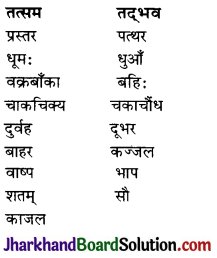
छन्द-परिचय – इस गीत में शुद्ध पर्यावरण स्थायी तत्त्व है। इसके अतिरिक्त सब स्थानों पर प्रत्येक पंक्ति में 26 मात्राएँ हैं। यह गीतिका छन्द का रूप है।
JAC Class 10th Sanskrit शुचिपर्यावरणम् Important Questions and Answers
शब्दार्थ चयनम् –
अधोलिखित वाक्येषु रेखांकित पदानां प्रसङ्गानुकूलम् उचितार्थ चित्वा लिखत –
प्रश्न 1.
दुर्वहमत्र जीवितं जातं प्रकृतिरेव शरणम्।
(अ) जातम्
(ब) दुष्करम्
(स) कालायसचक्रम्
(द) दुर्दान्तैः
उत्तरम् :
(ब) दुष्करम्
प्रश्न 2.
मनः शोषयत् तनुः पेषयद् भ्रमति सदा वक्रम –
(अ) कुटिलम्
(ब) अमुना
(स) वक्रम्
(द) पेषयद
उत्तरम् :
(अ) कुटिलम्

प्रश्न 3.
कज्जलमलिनं धूमं मुञ्चति शतशकटीयानम् –
(अ) ध्वानम्
(ब) वाष्पयानमाला
(स) त्यजति
(द) संधावति
उत्तरम् :
(स) त्यजति
प्रश्न 4.
यानानां पङ्क्तयो ह्यनन्ताः, कठिनं संसरणम् –
(अ) यानानाम्
(ब) अनन्ताः
(स) शरणं
(द) संचलनम्
उत्तरम् :
(द) संचलनम्

प्रश्न 5.
कुत्सितवस्तुमिश्रितं भक्ष्यं समलं धरातलम्।
(अ) अशुद्धम्
(ब) भृशम्
(स) मिश्रितम्
(द) शुद्धीकरणम्
उत्तरम् :
(अ) अशुद्धम्
प्रश्न 6.
प्रपश्यामि ग्रामान्ते निर्झर-नदी-पयःपूरम् –
(अ) कान्तारे
(ब) ग्रामान्ते
(स) प्रपात
(द) नगरात
उत्तरम् :
(स) प्रपात
प्रश्न 7.
कुसुमावलिः समीरचालिता स्यान्मे वरणीया –
(अ) पुष्पाणां पंक्तिः
(ब) ललितलतानाम्
(स) कुसुमावलिः
(द) नवमालिका
उत्तरम् :
(अ) पुष्पाणां पंक्तिः

प्रश्न 8.
अयि चल बन्धो ! खगकुलकलरव गुञ्जितवनदेशम् –
(अ) जनेभ्यः
(ब) गुञ्जित
(स) कान्तार प्रदेश
(द) खगकलकलरव
उत्तरम् :
(स) कान्तार प्रदेश
प्रश्न 9.
प्रस्तरतले लतातरुगुल्मा नो भवन्तु पिष्टाः –
(अ) लतातरुगुल्माः
(ब) दमिता
(स) निसर्गे
(द) समाविष्टाः
उत्तरम् :
(ब) दमिता
प्रश्न 10.
पाषाणी सभ्यता निसर्गे स्यान्न समाविष्टा –
(अ) कामये
(ब) मानवाय
(स) पर्यावरणम्
(द) प्रकृती
उत्तरम् :
(स) पर्यावरणम्
II. संस्कृतमाध्यमेन प्रश्नोत्तराणि –
एकपदेन उत्तरत –
(एक शब्द में उत्तर दीजिए)
प्रश्न 1.
कालायसचक्रं किं शोषयति ?
(लौहचक्र किसका शोषण करता है ?)
उत्तरम् :
मनः (मन का)।

प्रश्न 2.
दुर्दान्तैः दशनैः केन जनग्रसनं न स्यात् ?
(किसके विकराल दाँतों द्वारा लोगों का विनाश न हो?)
उत्तरम् :
कालायसचक्रेण
(लौहचक्र द्वारा)।
प्रश्न 3.
धावन्ती वाष्पयानमाला किं वितरति ?
(दौड़ती रेलगाड़ियों की माला क्या वितरण करती है ?)
उत्तरम् :
ध्वानम्
(शोर)।
प्रश्न 4.
कज्जलमलिनं धूमं किं मुञ्चति ?
(काजल-सा काला धुआँ कौन त्यागती है ?)
उत्तरम् :
शतशकटीयानम्
(सैकड़ों मोटरगाड़ियाँ)।
प्रश्न 5.
‘अनन्ताः’ कस्य पदस्य विशेषणम् ?
(‘अनन्ताः’ किस शब्द का विशेषण है ?)
उत्तरम् :
पङ्क्तयः
(पंक्तियाँ)।

प्रश्न 6.
कुत्सितवस्तु मिश्रितं किम् ?
(गंदी वस्तुओं से मिश्रित क्या है ?)
उत्तरम् :
भक्ष्यम्
(खाद्य)।
प्रश्न 7.
बहिरन्तर्जगति किं बहुकरणीयम् ?
(बाह्य और आन्तरिक जगत में क्या बहुत करना है ?)
उत्तरम् :
शुद्धीकरणम्
(शुद्धीकरण)।
प्रश्न 8.
कविः कुतः बहुदूरं गन्तुम् इच्छति ?
(कवि कहाँ से बहुत दूर जाना चाहता है ?)
उत्तरम् :
नगरात्
(नगर से)।
प्रश्न 9.
‘माम् नगरात् बहुदूरं नय’ इति वाक्ये सर्वनामपदं लिखत।
(‘माम् नगरात् बहुदूरं नय’ इस वाक्य में सर्वनाम पद लिखिए।)
उत्तरम् :
माम् (मुझे)।
प्रश्न 10.
नवमालिका के मिलिता रुचिरं प्रतिभाति ?
(नवमल्लिका किससे मिली सुन्दर लगती है ?)
उत्तरम् :
रसालम् (आम से)।

प्रश्न 11.
कुसुमावलिः केन चालिता मे वरणीया?
(किसके द्वारा संचालित फूलों की पंक्ति मेरे द्वारा वरण करने योग्य
उत्तरम् :
समीरेण (हवा द्वारा)।
प्रश्न 12.
जनाः केन सम्भ्रमिता: ?
(लोग किससे भ्रमित हैं ?)
उत्तरम् :
पुरकलरवेण (नगर के कोलाहल से)।
प्रश्न 13.
किं जीवितरसहरणम् ?
(जीवन के आनन्द रस का हरण करने वाला क्या है ?)
उत्तरम् :
चाकचिक्यजालम् (चकाचौंध करने वाला जगत्)।
प्रश्न 14.
का निसर्गे न समाविष्टा स्यात् ?
(प्रकृति में किसका समावेश न हो ?)
उत्तरम् :
पाषाणी सभ्यता (पाषाणकालीन सभ्यता)।

प्रश्न 15.
‘पाषाणी’ पदस्य विशेष्यं लिखत।
(‘पाषाणी’ पद का विशेष्य लिखिए।)
उत्तरम् :
सभ्यता।
प्रश्न 16.
‘मानवाय जीवनं कामये’ अत्र क्रियापदं किम् ?
(‘मानवाय जीवनं कामये’ यहाँ क्रियापद क्या है ?)
उत्तरम् :
कामये (चाहता हूँ)।
प्रश्न 17.
कुत्र दुर्वहम् जीवितम् ?
(जीना दूभर कहाँ है ?)
उत्तरम् :
महानगरमध्ये (महानगर के बीच में)।
प्रश्न 18.
अनिशं किं चलति?
(दिन-रात क्या चलता है?)
उत्तरम् :
कालायसचक्रम् (लोहे का पहिया)।
प्रश्न 19.
धूमं कीदृशम् अस्ति ?
(धुओँ कैसा है ?)
उत्तरम् :
कज्जलमलिनम् (काजल-सा काला)।

प्रश्न 20.
ध्वानं वितरन्ती का धावति ?
(शोर करती क्या दौड़ती है ?)
उत्तरम् :
वाष्पयानमाला (रेलगाड़ियों की माला)।
प्रश्न 21.
वायुमण्डलं कीदृशम् ?
(वायुमण्डल कैसा है?)
उत्तरम् :
दूषितम् (दूषित)।
प्रश्न 22.
धरातलं कीदृशम् अस्ति ?
(धरातल कैसा है ?)
उत्तरम् :
समलम् (मलिन)।
प्रश्न 23.
कविः निर्झर नदी-पयः पूरं कुत्र पश्यति ?
(कवि जल से भरे नदी-झरना कहाँ देखता है ?)
उत्तरम् :
ग्रामान्ते (गाँव की सीमा पर)।
प्रश्न 24.
कविः कीदृशे कान्तारे सञ्चरणम् इच्छति ?
(कवि कैसे वनप्रदेश में घूमना चाहता है ?)
उत्तरम् :
एकान्ते (एकान्त में)।
प्रश्न 25.
हरिततरूणां माला कीदृशी ?
(हरे वृक्षों की माला कैसी है?)
उत्तरम् :
रमणीया (सुन्दर)।

प्रश्न 26.
का समीरचालिता मे वरणीया स्यात् ?
(वायु से हिलाई गई मेरे वरण करने योग्य क्या हो ?)
उत्तरम् :
कुसुमावलिः (फूलों की पंक्ति)।
प्रश्न 27.
हरिततरूणां माला कीदृशी ?
(हरे वृक्षों की माला कैसी है?)
उत्तरम् :
रमणीया (सुन्दर)।
प्रश्न 28.
का समीरचालिता मे वरणीया स्यात् ?
(वायु से हिलाई गई मेरे वरण करने योग्य क्या हो ?)
उत्तरम् :
कुसुमावलिः (फूलों की पंक्ति)।
प्रश्न 29.
वनदेशं केन गुञ्जितम् ?
(वनप्रदेश किससे गुंजित है ?)
उत्तरम् :
खगकलरवेण (पक्षियों के कलरव से)।
प्रश्न 30.
अत्र केभ्यः सुख सन्देशम् ?
(यहाँ सुख का सन्देश किनके लिए है ?)
उत्तरम् :
सम्भ्रमितजनेभ्यः (भ्रमित लोगों के लिए)।

प्रश्न 31.
कविः कस्मै जीवनं कामयते ?
(कवि किसके जीवन की कामना करता है ?)
उत्तरम् :
मानवाय (मानव के)।
प्रश्न 32.
लतातरुगुल्माः कस्य तले न पिष्टाः भवन्तु ?
(बेलों और पेड़ों के समूह किसके नीचे नहीं पिसें ?)
उत्तरम् :
प्रस्तरतले (पत्थर के नीचे)।
पूर्णवाक्येन उत्तरत (पूरे वाक्य में उत्तर दीजिए)
प्रश्न 33.
कालायसचक्रं किं किं करोति. ?
(लौहचक्र क्या-क्या करता है ?)
उत्तरम् :
कालायसचक्रं मनः शोषयति तनुः च पेषयति।
(लौहचक्र मन का शोषण करता है और शरीर को पीसता है।)
प्रश्न 34.
नगरेषु किं किं प्रदूषितम् भवति ?
(नगरों में क्या-क्या प्रदूषित होता है ?)
उत्तरम् :
नगरेषु वायुमण्डलं, जलं, भोजनं धरातलं च दूषितं भवति।
(नगरों में वायुमण्डल, जल, भोजन और धरती दूषित होती है।)

प्रश्न 35.
ग्रामान्ते कविः किं पश्यति?
(गाँव की सीमा पर कवि क्या देखता है ?)
उत्तरम् :
ग्रामान्ते कविः निर्झर-नदी-पयः पूरं पश्यति।
(गाँव की सीमा पर कवि नदी, झरने जल से परिपूर्ण देखता है।)
प्रश्न 36.
केषां माला रमणीया ?
(किनकी माला सुन्दर है ?)
उत्तरम :
हरिततरूणां ललितलतानां माला रमणीया।
(हरे वृक्षों और सुन्दर बेलों की पंक्ति रमणीय है।)
प्रश्न 37.
अत्र जीवितं कीदृशं जातम् ?
(यहाँ जीवन कैसा हो गया है?)
उत्तरम् :
अत्र जीवितं दुर्वहं जातम्।
(यहाँ जीवन दूभर हो गया है।)

प्रश्न 38.
शतशकटीपान कि मुञ्चति ?
(सैकड़ों मोटरगाड़ियाँ क्या छोड़ती है ?)
उत्तरम् :
शतशकटीयानं कज्जलमलिनं धूम मुन्धति।
(सैकड़ों मोटरगाड़ियाँ काजल के समान काला धुआँ छोड़ती हैं।)
प्रश्न 39.
नगरेषुकीदर्श भक्ष्य मिलति ?
(नगरों में कैसा खाना मिलता है?)
उत्तरम् :
नगरेषु कत्सितवस्तु-निर्मितं भोजनं मिलति।
(नगरों में दूषित वस्तुओं से बना भोजन मिलता है।)
प्रश्न 40.
कविः कुत्र सञ्चरणम् इच्छति ?
(कवि कहाँ विचरण करना चाहता है ?)
उत्तरम् :
कवि: एकान्ते कान्तारे सञ्चरणम् इच्छति।
(कवि एकान्त वनप्रदेश में घूमना चाहता है।)
प्रश्न 41.
कीदृशी कुसुमावलिः कवये वरणीया स्यात् ?
(कैसी फूलों की पंक्ति कवि के लिए वरण करने योग्य है ?)
उत्तरम् :
समीरचालिता कुसुमावलिः कवये वरणीया स्यात्।
(वायु द्वारा हिलाई गई फूलों की पंक्ति कवि के लिए वरण करने योग्य है।)
प्रश्न 42.
कीदृशी कुसुमावलिः कवये वरणीया स्यात् ?
(कैसी फूलों की पंक्ति कवि के लिए वरण करने योग्य है ?)
उत्तरम् :
समीरचालिता कुसुमावलिः कवये वरणीया स्यात्।
(वायु द्वारा हिलाई गई फूलों की पंक्ति कवि के लिए वरण करने योग्य है।)

प्रश्न 43.
कविः कीदृशं देशं गन्तुम् इच्छति ?
(कवि कैसे देश को जाना चाहता है ?)
उत्तरम् :
कविः खगकुलकलरव गुञ्जित वनदेशं गन्तुम् इच्छति।
(कवि पक्षियों के कलरव से गुञ्जित वनप्रदेश को जाना चाहता है।)
प्रश्न 44.
प्रस्तरतले के न पिष्टाः भवन्तु ?
(पत्थरों के नीचे क्या नहीं कुचले?)।
उत्तरम् :
प्रस्तरतले लतातरुगुल्माः पिष्टाः न भवन्तु।
(पत्थरों के नीचे बेल, वृक्ष और झाड़ियाँ न कुचलें।)
प्रश्न 45.
‘शुचिपर्यावरणम्’ इत्यस्य पाठस्य भावबोधनं सरलसंस्कृतभाषया लिखत।
(‘शुचिपर्यावरणम्’ पाठ का भाव सरल संस्कृत भाषा में लिखिए।)
उत्तरम् :
अद्य महानगरेषु यन्त्राणि चलानि। वाष्पयानानि शकटीयानानि चलन्ति। एते पर्यावरणं प्रदूषयन्ति। भोजनम् अपि कुत्सितवस्तु मिश्रितम् अस्ति। ध्वनिः अपि कौँ स्फोटयति। अतः अत्र जीवितं दुर्वहं जातम्। अधुना प्रकृतिः एव मात्र शरणम् अस्ति। कवि प्रकृतेः शरणं गन्तुम् इच्छति। सः मानवाय जीवनं कामयते।
(आज महानगरों में मशीनें चलती हैं। रेलगाड़ियाँ और मोटरगाड़ियाँ चलती हैं। ये सब पर्यावरण को प्रदूषित करती हैं। भोजन भी गन्दी वस्तुओं से मिश्रित है। ध्वनि भी कानों को फोड़ती है। अत: यह जीवन दूभर हो गया है। अब प्रकृति ही एकमात्र आश्रय है। कवि प्रकृति की शरण में जाना चाहता है। वह मानव के लिए जीवन की कामना करता है।)
III. अन्वय-लेखनम् –
अधोलिखितश्लोकस्यान्वयमाश्रित्य रिक्तस्थानानि मञ्जूषातः समुचितपदानि चित्वा पूरयत।
(नीचे लिखे श्लोक के अन्वय के आधार पर रिक्तस्थानों की पूर्ति मंजूषा से उचित पद चुनकर कीजिए।)
1. महानगरमध्ये ……………………………………. जनग्रसनम्।।
मञ्जूषा – दशनैः, महानगरमध्ये, अनिशं, पेषयत्।
कालायसचक्रम् (i) ………………. (ii)……………….. चलत्, मनः शोषयत्, तनुः (iii) ……………. सदा वक्र भ्रमति, अमुना दुर्दान्तैः (iv) ……………. जनग्रसनम् एव स्यात्।
उत्तरम् :
(i) अनिशं
(i) महानगरमध्ये
(iii) पेषयत्
(iv) दशनैः।

2. कज्जलमलिनं ……………………………………. संसरणम्।।
मञ्जूषा – यानानाम्, वाष्पयानमाला, कज्जलमलिनम, संसरणम्।
शतशकटीयानं (i) ……………. धूमं मुञ्चति। ध्वानं वितरन्ती (ii) …………… संधावति (iii) …………. पतयः अनन्ताः हि (iv) …………… कठिनम्।
उत्तरम् :
(i) कज्जलमलिनम्
(ii) वाष्पयानमाला
(iii) यामामाम्
(iv) संसरणम्।
3. वायुमण्डल …………………………….. शुद्धीकरणम्।।
मञ्जूषा – कुत्सितबस्तु, निर्मलम्, पूषितम्, शुद्धीकरणम्।
वायुमण्डलं भृशं (i)……. हि जलं (ii) …….. न, भक्ष्यं (iii) …….. मिश्रितं, धरातलं, समलं, तु बहि-अन्तः जगति बहु (iv)…… करणीयं स्यात्।
उत्तरम् :
(i) दूषितम्
(ii) निर्मलम्
(iii) कुत्सितवस्तु
(iv) शुद्धीकरणम्।
4. कश्चित्कालं ……………………………………. सञ्चरणम्।।
मञ्जूषा – अस्मात्, कान्तारे, प्रपश्यामि, नय।
कश्चित् कालात् माम् (i) ……… नगरात् बहुदूरं (ii) …………..। ग्रामान्ते निर्झर-नदी-पयः पूरं (iii) ………….. एकान्ते (iv) …………….. क्षणमपि मे सञ्चरणं स्यात्।
उत्तरम् :
(i) अस्मात्
(ii) नय
(iii) प्रपश्यामि
(iv) कान्तारे।

5. हरिततरूणां …………………………. संगमनम्।
मञ्जूषा – नवमालिका, समीरचालिता, ललितलतानां, रुचिरं।
हरिततरूणां (i) ……… रमणीया माला, (ii) ……… कुसुमावलिः मे वरणीया स्यात्। (iii) ……… मिलिता रसालं (iv) ……… सङ्गमनम्।
उत्तरम् :
(i) ललितलतानां
(ii) समीरचालिता
(iii) नवमालिका
(iv) रुचिरं।
6. अयि चल …………………… कुर्याज्जीवितरसहरणम्।
मञ्जूषा – हरणम्, सम्भ्रमित, खगकुल, चाकचिक्यजालं।
अयि बन्धो ! (i) ……… कलरव गुञ्जित वनदेशं चल। पुर-कलरव (ii) ……… जनेभ्यः सुख सन्देशं धृत, (iii) ……… नो जीवित रस (iv) ……… कुर्यात्।
उत्तरम् :
(i) खगकुल
(ii) सम्भ्रमित
(iii) चाकचिक्यजालं
(iv) हरणम्।
7. प्रस्तरतले ……………………………… जीवन्मरणम्।
मञ्जूषा – निसर्गे, प्रस्तरतले, जीवन्, मानवाय।
लतातरुगुल्मा (i)……… पिष्टाः न भवन्तु। पाषाणीसभ्यता (ii)……… समाविष्टा न स्यात्। (iii)……… जीवनं कामये नो (iv)……… मरणम्।
उत्तरम् :
(i) प्रस्तरतले
(ii) निसर्गे
(iii) मानवाय
(iv) जीवन्।

IV. प्रश्ननिर्माणम –
अधोलिखित वाक्येषु स्थूलपदमाभृत्य प्रश्न निर्माणं कुरुत –
- दुर्वहम् अत्र जीवितं जातम्। (यहाँ जीवन दूभर हो गया है।)
- महानगरमध्ये चलदनिशं कालायसचक्रम्। (महानगर में दिन-रात लोहे का पहिया चलता है।)
- कज्जलमलिनं धूमं मुञ्चति शतशकटीयानम्। (सैकड़ों मोटरगाड़ियाँ काजल-सा मलिन धुऔं त्यागती हैं।)
- वाष्पयानमाला संधावति वितरन्ती ध्वानम्। (रेलगाड़ियों की पंक्ति शोर करती दौड़ रही है।)
- वाष्पयानमाला ध्वानं वितरन्ती संधावति। (रेलगाड़ियों की पंक्ति शोर करती दौड़ रही है।)
- यानानां पङ्क्तयो ह्यनन्ता। (वाहनों की पंक्तियाँ अनन्त हैं।)
- वायुमण्डलं भृशं दूषितम्। (वायुमण्डल बहुत दूषित है।)।
- बहिरन्तर्जगति तु बहु शुद्धीकरणं करणीयम्। (बहिर् और अन्तर्जगत में बहुत शुद्धीकरण करना चाहिए।)
- ग्रामान्ते निर्झर-नदी-पयःपूरं प्रपश्यामि। (गाँव के अंत में जल से भरपूर झरने और नदी देखता हूँ।)
- प्रकृत्याः सन्निधौ वास्तविकं सुखं विद्यते। (प्रकृति के सान्निध्य में असली सुख विद्यमान है।)
उत्तराणि :
- कीदृशम् अत्र जीवितं जातम् ?
- महानगरमध्ये किं चलदनिशम् ?
- कीदृशं धूमं मुञ्चति शतशकटीयानम्?
- का सन्धावति वितरन्ती ध्वानम् ?
- वाष्पयानमाला किं वितरन्ती सन्धावति ?
- केषां पङ्क्तयो ह्यनन्ताः ?
- किं भृशं दूषितम्।
- बहिरन्तर्जगति तु किं करणीयम् ?
- ग्रामान्ते किं प्रपश्यामि ?
- केषां सन्निधौ वास्तविक सुखं विद्यते ?
V. भावार्थ लेखनम् –
अधोलिखितपद्यानां संस्कृते भावार्थं लिखत –
1. दुर्वहमत्र जीवितं ……………………… स्यान्नैव जनग्रसनम् ॥
भावार्थ – अस्मिन् स्थाने जीवनमपि दुष्करमभवत्। अत प्राकृतिक स्थलानां शुद्ध पर्यावरणमेव (एकमात्र) आश्रयः। लौहचक्रम दिवारात्रम् महत्स नगरेष गतिमानस्ति। मनसः शोषणं कुर्वन् शरीरं च पिष्टीकर्वन चूर्णयन वा सदैव कटिलं (चक्रवत्) घूर्णति। अनेन विकरालै दन्तैः मानवानां भक्षणं (पीडनं) न भवेत्। अतः शुद्धं पर्यावरणमेव (प्राणिनाम्) आश्रयमस्ति।

2. कज्जलमलिनं धूमं ………………………. कठिनं संसरणम्।
भावार्थ – शतसंख्यकानि वाहनानि कज्जल सदृशं मलिनं धूमजालं वमन्ति त्यजन्ति वा ध्वनिं कुर्वन्ती लौहपथ गामिनीनां पंक्ति निरन्तरं धावति। वाहनानां पङ्क्तयः असीमिता: अन्तहीनाः वा पंक्तयः सन्ति अतः सञ्चलनमपि दुष्करं जातम् अतः शुद्ध वातावरणम् (इदानी) एकमात्रं आश्रयम् अस्ति।
3. वायुमण्डलं भृशं ………………………. बहु शुद्धीकरणम्।
भावार्थ – समीर मण्डलं प्रभूतं दोषपूर्णं (जातम्)। यतः न वारि शुद्धं न भोजनं (शुद्धम्) पदार्थाः दूषिताः मिश्रिताः च पृथ्वीतलमपि अशुद्धमस्ति। तर्हि आन्तरिके बाह्ये च जगति भृशं पवित्रीकरणं कर्त्तव्यम्। शुद्धं वातावरणमिदानीं एकमात्र आश्रयम् अस्ति।
4. कञ्चित् कालं नय ……………………… मे स्यात् सञ्चरणम्।
भावार्थ – किञ्चित्समयं माम् एतस्मात् पत्तनात् भृशं दूरं गमय, ग्रामस्य सीम्नि अहं जलपूर्ण प्रपातं सरितां चावलोकयामि, निर्जने वने क्षणमपि मम विचरणं भवेत् यतः शुद्धं पर्यावरणमेव एकमात्रं आश्रय।

5. हरिततरूणां ललितलतानां …………………. रुचिरं संगमनम्।
भावार्थ – हरितवर्ण वृक्षाणां, रम्य वल्लरीणां रम्या पङ्क्तिः पवनेन वेपिता पुष्पाणां पङ्क्तिः मह्यं वरणाय भवेत्। नूतना मल्लिका सहकारेण मिलित्वा सुन्दरं मेलनं प्राप्नोति। शुद्ध पर्यावरणमेवाद्य (मानव जीवनस्य) आश्रय।
6. अयि चल बन्धो ! …………………. नो कुर्याज्जीवितरसहरणम्।
भावार्थ – हे भ्रातः! पक्षिणां समवेत स्वरेण गुञ्जायमानं कान्तारप्रदेशं चल यत् नगरस्य ध्वानेन सम्यक् भ्रान्तेभ्यः मानवेभ्यः सुखस्य समाचारं धारयति। अप्राकृतं जीवनरस हर्तारं इदं जगत् जीवन सुखं न हरेत्। (अद्य मानवाय) शुद्ध वातावरणमेव मात्राश्रयः।
7. प्रस्तरतले लतातरुगुल्मा …………………………….. नो जीवन्मरणम्।
संस्कृत व्याख्याः – वल्लर्यः वृक्षाः कण्टस्तवा इत्यादयः प्राकृतिक सम्पदः शिलातले दमिता न भवन्तु। प्रकृतौ पाषाणकालीन सभ्यतायाः समावेशः न भवेत्। अहं मनुष्याय जीवनं इच्छामि न तु जीवनं मरणं च। शुद्ध वातावरणमेवाश्रय अस्ति।
शुचिपर्यावरणम् Summary and Translation in Hindi
पाठ-परिचय – निरन्तर बढते हए पर्यावरण-प्रदषण से आज सम्पूर्ण विश्व पीडित है। पथ्वी, जल, व तेज सभी तो प्रदूषित हो गए हैं। मानव मन को शान्ति कहाँ मिले। विश्वव्यापी इसी समस्या से अनुप्रेरित होकर आधुनिक संस्कृत-कवि हरिदत्त शर्मा ने यह कविता लिखी है। ‘शुचिपर्यावरणम्’ उनके ‘लसल्लतिका’ गीत-संग्रह में संकलित है। इसमें कवि महानगरों की यान्त्रिक बहुलता से बढ़ते प्रदूषण पर चिन्ता व्यक्त करते हुए कहता है कि यह लौहचक्र तन-मन का शोषक है, जिससे वायु-मण्डल और भूमण्डल दोनों मलिन हो रहे हैं। प्रस्तुत कविता के प्रथम तीन श्लोकों में कवि ने यान्त्रिक वृद्धि के कारण प्रदूषित पर्यावरण तथा वायुमण्डल प्रदूषण का वर्णन किया है, चौथे से सातवें श्लोकों में कवि शुद्ध जलवायु-युक्त हरे-भरे वृक्षों से घिरे पक्षियों की संगीत लहरी से गुंजित शुद्ध-पर्यावरण में जाने की अभिलाषा करता है।
मूलपाठः, अन्वयः,शब्दार्थाः, सप्रसंग हिन्दी-अनुवादः
1 दुर्वहमत्र जीवितं जातं प्रकृतिरेव शरणम्।
शुचि-पर्यावरणम्॥
महानगरमध्ये चलदनिशं कालायसचक्रम्।
मनः शोषयत् तनुः पेषयद् भ्रमति सदा वक्रम्॥
दुर्दान्तैर्दशनैरमुना स्यान्नैव जनग्रसनम् ॥ शुचि…. ॥1॥
अन्वयः – अत्र जीवितं दुर्वहं जातं, (अत:) प्रकृतिः, शुचि-पर्यावरणम् एव शरणम्। कालायसचक्रम् अनिशं महानगरमध्ये चलत्, मनः शोषयत्, तनुः पेषयत् सदा वक्रम् भ्रमति, अमुना दुर्दान्तैः दशनैः जनग्रसनम् एव स्यात्। शुचिपर्यावरणमेव शरणम्।
शब्दार्थाः – अत्र = अस्मिन् संसारे (यहाँ, इस संसार में), जीवितम् = जीवनम् (जीवन), दुर्वहम् = दुष्करम् (कठिन, दूभर), जातम् = भूतं, उत्पन्नम् (हो गया है), अतः प्रकृतिः = अतः प्राकृतिकस्थलम् (अतः प्रकृति), शुचि-पर्यावरणम् एव = शुद्ध-पर्यावरणम् एव (स्वच्छ, शुद्ध वातावरण ही), शरणम् = आश्रयः (आश्रय योग्य है) अर्थात् शुद्ध पर्यावरण की शरण में ही जाना चाहिए। कालायसचक्रम् = लौहचक्रम् (लोहे का पहिया), अनिशम् = अहर्निशम् (दिन-रात), महानगरमध्ये = विशाल नगरेषु, महत्सु नगरेषु (महानगरों में), चलत् = गतिमत्, प्रवृत्तमानम् (चलता हुआ), मनः शोषयत् = मनसः शोषणं कुर्वत् (मन का शोषण करता हुआ), तनुः = शरीरम् (शरीर को), पेषयद् = पिष्टीकुर्वत् (पीसता हुआ), सदा = सर्वदा, सदैव (हमेशा, सदैव), वक्रम् = कुटिलम् (टेढ़ा-मेढ़ा, वक्रगति से), भ्रमति = घूर्णति (घूमता है), अमुना = अनेन (इसके द्वारा), दुर्दान्तः = विकरालैः, भयङ्करैः (विकराल), दशनैः = दन्तैः (दाँतों से), जन-ग्रसनम् एव = मानवानां भक्षणम्, नीगीर्णनिम् एव (मानव का विनाश ही), स्यात् = भवेत् (होना चाहिए, होगा), अतः शुचि-पर्यावरणम् एव = शुद्धं वातावरणमेव (स्वच्छ जलवायु ही), शरणम् = आश्रयः (एकमात्र सहारा है।)
सन्दर्भ – प्रसङ्गश्च – यह गीतांश हमारी ‘शेमुषी’ पाठ्यपुस्तक के ‘शुचि पर्यावरणम्’ पाठ से लिया गया है। यह पाठ प्रो. हरिदत्त शर्मा-रचित ‘लसल्लतिका’ गीतिसंग्रह से सङ्कलित है। इस पाठ में कवि पर्यावरण प्रदूषण के आधार पर लिखता
हिन्दी-अनुवादः – इस संसार में जीवन दूभर हो गया है, अतः प्रकृति का शुद्ध-पर्यावरण ही (एकमात्र) सहारा है अर्थात् शुद्ध पर्यावरण की शरण में ही जाना चाहिए। (यह) लोहे का पहिया (यन्त्रजाल) दिन-रात महानगरों में चलता हुआ, मन का शोषण करता हुआ, शरीर को पीसता हुआ हमेशा टेढ़ा-मेढ़ा वक्रगति से घूमता है। इसके विकराल दाँतों द्वारा मानव का विनाश ही (किया जा रहा है) होगा। अतः शुद्ध पर्यावरण की शरण में ही जाना चाहिए।

2. कज्जलमलिनं धूमं मुञ्चति शतशकटीयानम्।
वाष्पयानमाला सन्धावति वितरन्ती ध्वानम् ॥
यानानां पङ्क्तयो ह्यनन्ताः, कठिनं संसरणम्। शुचि……॥2॥
अन्वयः – शतशकटीयानम् कज्जलमलिनं धूमं मुञ्चति, ध्वानं वितरन्ती वाष्पयानमाला संधावति, यानानां पङ्क्तयः अनन्ताः हि संसरणं कठिनम्। शुचिपर्यावरणं शरणम्।।
शब्दार्थाः – शतशकटीयानम् = शकटीयानानां शतम् (सैकड़ों मोटर-गाड़ियाँ), कज्जलमलिनं धूमम् = कज्जलेन मलिनम् वाष्पः (काजल-सा मलिन अर्थात् काला धुआँ), मुञ्चति = त्यजति, वमति (त्यागती, छोड़ती या उगलती हैं)। ध्वानम् = (शोर), वितरन्ती = ददाति (देती, करती हुई), वाष्पयानमाला = वाष्पयानानां, लौहपथगामिनीनां पङ्क्तिः (रेलगाड़ियों की पंक्ति), संधावति = निरन्तरं धावति (निरन्तर दौड़ रही हैं), यानानाम् = वाहनानाम् (वाहनों की), पङ्क्तयः = मालाः, परम्पराः (पङ्क्तियाँ), अनन्ताः = असीमिताः, अन्तहीनाः (असीमित हैं), हि = अतः (इसलिए), संसरणम् = गमनम्, सचलनम् (चलना), कठिनम् = दुष्करम् (दूभर हो गया है), शुचि पर्यावरण = शुद्धवातावरण (शुद्ध पर्यावरण), शरणं = आश्रयः (आश्रय है)।
सन्दर्भ-प्रसङ्गश्च – यह गीतांश हमारी ‘शेमुषी’ पाठ्यपुस्तक के ‘शुचि पर्यावरणम्’ पाठ से लिया गया है। यह पाठ प्रो. हरिदत्त शर्मा रचित ‘लसल्लतिका’ गीति-संग्रह से संकलित है।
हिन्दी-अनुवादः – सैकड़ों मोटरगाड़ियाँ काजल-सा मलिन धुआँ अर्थात् काला-काला धुआँ छोड़ती हैं। शोर करती हुई रेलगाड़ियों की पंक्तिः निरन्तर दौड़ रही है। वाहनों की पंक्तियाँ असीमित (अन्त न होने वाली) हैं इसलिए (रास्ते में) चलना भी दूभर हो गया है। अतः शुद्ध पर्यावरण की शरण में चलना चाहिए।

3. वायुमण्डलं भृशं दूषितं न हि निर्मलं जलम्।
कुत्सितवस्तुमिश्रितं भक्ष्यं समलं धरातलम् ॥
करणीयं बहिरन्तर्जगति तु बहु शुद्धीकरणम्। शुचि……॥3॥
अन्वयः – वायुमण्डलं भृशं दूषितं हि जलं निर्मलं न, भक्ष्यं कुत्सित वस्तु-मिश्रितम्, धरातलम् समलम् तु बहिः अन्तः जगति बहु शुद्धीकरणं करणीयम्। शुचि-पर्यावरणं शरणम्।
शब्दार्थाः – वायुमण्डलम् = वातावरणम्, समीरमण्डलम् (वायुमण्डल), भृशम् = अत्यधिकं, बहुः, प्रभूतम् (अत्यधिक, अत्यन्त), दूषितम् = दोषपूर्णम्, अशुद्धं, दूषणमयम् जातम् (प्रदूषित, दूषित हो गया है), हि = यतः (क्योंकि), जलम् = तोयः, वारि, पानीयम् (पानी भी), निर्मलम् = शुद्धम्, मलहीनम् (शुद्ध, स्वच्छ), न = नहि (नहीं है), भक्ष्यम् = खाद्यम्, भोजनम् (खाने की वस्तुएँ), कुत्सितवस्तु = दूषित पदार्थ, गर्हित वस्तु (बुरी या दूषित वस्तु), मिश्रितम् = युक्तम् (युक्त, मिलावट वाला है), धरातलम् = पृथ्वीतलम्, भूतलम् (धरती), समलम् = मलयुक्तम्, अशुद्धम्, अपावनम् (मैली अर्थात् गन्दगी युक्त है), तु = तर्हिः, तदा (तो, अतएव), बहिः अन्तः जगति = बाह्ये आन्तरिके च जगति (बाह्य एवं आन्तरिक जगत् में), बहुः = भृशम्, प्रभूतम् (अत्यधिक, अनेक, बहुत), शुद्धीकरणम् = पवित्रीकरणम् (शुद्धीकरण), करणीयम् = कर्त्तव्यम्, कार्यम् (करना चाहिए), शुचि = शुद्धम् (शुद्ध, स्वच्छ), पर्यावरणम् = वातावरणम् (पर्यावरण ही), शरणम् = मात्र आश्रयम् जातम् (एकमात्र शरण रह गया है)।
सन्दर्भ-प्रसङ्गश्च – यह गीतांश हमारी ‘शेमुषी’ पाठ्यपुस्तक के ‘शुचिपर्यावरणम्’ पाठ से लिया गया है। यह गीत प्रो. हरिदत्त शर्मा लिखित ‘लसल्लतिका’ गीति-संग्रह से संकलित है। इस गीतांश में कवि वाहनों के धुएँ से प्रदूषित पर्यावरण के विषय में कहता है।
हिन्दी-अनुवादः – वायुमण्डल अत्यधिक दूषित हो गया है, क्योंकि पानी भी स्वच्छ नहीं है। खाने की वस्तुएँ भी दूषित पदार्थों से युक्त हैं। धरती मैली अर्थात् गन्दगीयुक्त है। अतएव बाह्य एवं आन्तरिक जगत् में अत्यधिक शुद्धीकरण करना चाहिए। शुद्ध पर्यावरण ही एकमात्र आश्रय है।

4. कञ्चित् कालं नय मामस्मान्नगराद् बहुदूरम्।
प्रपश्यामि ग्रामान्ते निर्झर-नदी-पयःपूरम् ॥
एकान्ते कान्तारे क्षणमपि मे स्यात् सञ्चरणम्। शुचि…… ॥4॥
अन्वयः – कञ्चित् कालम् माम् अस्मात् नगरात् बहुदूरं नय। (अहं) ग्रामान्ते पयः पूरं निर्झरं, नदी (च) प्रपश्यामि!, एकान्ते कान्तारे क्षणमपि मे सञ्चरणं स्यात्। शुचिपर्यावरणं शरणम्।
शब्दार्थाः – कञ्चित् कालम् = किञ्चित् समयम् (कुछ समय के लिए), माम् = मा, कविम् (मुझ कवि को), अस्मात् = एतस्मात् (इस), नगरात् = पुरात्, पत्तनात् (शहर से), बहुदूरम् = भृशंदूरम्, अत्यधिक दूरम् (बहुत दूर), नय गमय, प्रापय (ले चल), ग्रामान्ते = ग्रामस्य सीमायाम्, सीम्नि (गाँव की सीमा पर), निर्झरं – प्रपात, स्रोत (झरना), नदी सरिता (नदी), पयःपूरम् = जलेनपूर्णम् जलाशयम् (जलाशय को), प्रपश्यामि = अवलोकयामि, ईक्षे (देखता हूँ), एकान्ते = निर्जने (निर्जन, शान्त), कान्तारे = वने (जंगल में), क्षणमपि = क्षणमात्रम् (क्षणभर), मे = मम (मेरा), सञ्चरणम् = विचरण, भ्रमणम् (घूमना), स्यात् = भवेत् (होना चाहिए), अतः शुचि = शुद्धं (शुद्ध), पर्यावरणम् = वातावरणम् (पर्यावरण ही), शरणम् = आश्रयः (सहारा है)।
सन्दर्भ-प्रसङ्गश्च – यह गीतांश हमारी ‘शेमुषी’ पाठ्यपुस्तक के ‘शुचिपर्यावरणम्’ पाठ से लिया गया है। यह पाठ प्रो. हरिदत्त शर्मा रचित ‘लसल्लतिका’ गीति-संग्रह से संकलित है। इस गीतांश में कवि पावन पर्यावरण का चित्रण करता है।
हिन्दी-अनुवादः – कुछ समय के लिए मुझे इस शहर से बहुत दूर ले चलो। गाँव की सीमा पर (मैं) जल से पूर्ण झरने और नदी को देख रहा हूँ। (उस) निर्जन शान्त वन में मेरा एक क्षण भी घूमना हो जाए अर्थात् मैं वहाँ क्षणभर घूमना चाहता हूँ। अतः शुद्ध पर्यावरण ही एकमात्र आश्रय है।

5. हरिततरूणां ललितलतानां माला रमणीया।
कुसुमावलिः समीरचालिता स्यान्मे वरणीया ॥
नवमालिका रसालं मिलिता रुचिरं संगमनम्। शुचि…..॥5॥
अन्वयः – हरिततरूणां ललितलतानां रमणीया माला, समीरचालिता कुसुमावलिः मे वरणीया स्यात्। नवमालिका मिलिता रसालं रुचिरं सङ्गमनम्। शुचिपर्यावरणं शरणम्।
शब्दार्थाः – हरिततरूणाम् = हरिद्वर्णानां वृक्षाणाम् (हरे-भरे वृक्षों की), ललितलतानाम् = रम्याणां बल्लरीणाम् (सुन्दर बेलों की), रमणीया – रम्या, मनोहरा (सुन्दर), माला = पंक्तिः, श्रेणिः, हारः (माला, पंक्ति), समीर = पवनेन, वायुना (वायु द्वारा), चालिता = वेपिता, सञ्चालिता (हिलाई हुई), कुसुमावलिः = पुष्पाणां पंक्तिः (फूलों की पंक्ति), मे = मह्यम् (मेरे लिए), वरणीया = वरणाय, वरप्रदानाय (वरण करने योग्य, प्रसन्नता देने वाली), स्यात् = भवेत् (होनी चाहिए), नवमालिका = नूतना मल्लिका (नवमल्लिका), मिलिता रसालम् = आम्रवृक्षेण, सहकारेण मिलिता, बलयिता (आम के पेड़ से लिपटी हुई), रुचिरं = सुन्दरम् (सुन्दर), सङ्गमनम् = मिलनं प्राप्नोति (संगम प्राप्त कर रही है), शुचि = स्वच्छं, शुद्धं (स्वच्छ), पर्यावरणम् = वातावरणम् (जलवायु, पर्यावरण), शरणम् = आश्रयः (आश्रय है)।
सन्दर्भ-प्रसङ्गश्च – यह गीतांश हमारी शेमुषी’ पाठ्य-पुस्तक के ‘शुचिपर्यावरणम्’ पाठ (गीत) से लिया गया है। यह पाठ प्रो. हरिदत्त शर्मा रचित ‘लसल्लतिका’ गीति-संग्रह से संकलित है। इस गीत में कवि प्रकृति की रमणीयता का वर्णन करता है।
हिन्दी-अनुवादः – हरे-भरे वृक्षों और सुन्दर बेलों की पंक्ति (और) वायु द्वारा हिलाई जाती हुई फूलों की पंक्ति मेरे लिए वरण करने योग्य होनी चाहिए। नवमल्लिका आम के वृक्ष के साथ मिलकर सुन्दर संगम प्राप्त कर रही है। अतः स्वच्छ वातावरण ही एकमात्र आश्रय है।
6. अयि चल बन्धो ! खगकुलकलरव गुञ्जितवनदेशम्।
पुर-कलरव सम्भ्रमितजनेभ्यो धृतसुखसन्देशम् ॥
चाकचिक्यजालं नो कुर्याज्जीवितरसहरणम्। शुचि……॥6॥
अन्वयः – अयि बन्धो ! खगकुल कलरव गुञ्जित वनदेशं चल। पुर-कलरव सम्भ्रमित जनेभ्यः सुख सन्देशं धृत, चाकचिक्यजालं नो जीवित रस हरणम् कुर्यात्। शुचि पर्यावरणं शरणम्।
शब्दार्थाः – अयि बन्धो ! = हे भ्रातः ! (हे भाई !), खगकुलकलरव = पक्षिणां सामूहिक ध्वनिः, ध्वानेन (पक्षियों की सामूहिक ध्वनि से), गुञ्जित = गुञ्जायमानम् (गूंजते हुए), वनदेशम् चल = कान्तार प्रदेशं चल (वनप्रदेश को चलो), पुर-कलरव = नगरस्य ध्वानेन (नगर के शोरगुल से), सम्भ्रमित = सम्यक् भ्रमित, भयभीत (भ्रमित हुए या भयभीत), जनेभ्यः = मानवेभ्यः (लोगों के लिए), धृतसुखसन्देशम् = (सुख का सन्देश धारण किया हुआ है), चाकचिक्यजालम् = कृत्रिमं प्रभावपूर्ण जगत् (बनावटी आकर्षण पैदा करने वाला, चकाचौंध करने वाला जगत्), जीवित रस हरणम् = जीवनस्य सुखस्यापहरणम् (जीवन के सुखरूपी रस का हरण), नो = (नहीं), कुर्यात् = कुर्वीत (करना चाहिए), शुचि = शुद्धम् (शुद्ध), पर्यावरणम् = वातावरणम् (पर्यावरण ही), शरणम् = आश्रयः (आश्रय है)।
सन्दर्भ-प्रसङ्गश्च – यह गीतांश हमारी ‘शेमुषी’ पाठ्य-पुस्तक के ‘शुचिपर्यावरणम्’ पाठ से लिया गया है। यह गीत प्रो. हरिदत्त शर्मा द्वारा ‘लसल्लतिका’ गीति-संग्रह से संकलित है।
हिन्दी-अनुवादः – हे भाई ! पक्षियों की सामूहिक ध्वनि से गूंजते हुए वनप्रदेश की ओर चलो। (जो) नगर के शोरगुल से भयभीत लोगों के लिए सुख का सन्देश धारण किया हुआ है अर्थात् नगर के शोरगुल से थके हुए लोगों के लिए यहाँ सुख मिलता हैं। चकाचौंध करने वाला यह जगत् (कहीं) जीवन के सुख का अपहरण न कर ले। अतः शुद्ध पर्यावरण ही एकमात्र शरण (आश्रय) है।
7. प्रस्तरतले लतातरुगुल्मा नो भवन्तु पिष्टाः।
पाषाणी सभ्यता निसर्गे स्यान्न समाविष्टा ॥
मानवाय जीवनं कामये नो जीवन्मरणम्। शुचि…..॥7॥
अन्वयः – लतातरुगुल्मा प्रस्तरतले पिष्टाः न भवन्तु। पाषाणीसभ्यता निसर्गे समाविष्टा न स्यात्। मानवाय जीवनं कामये नो जीवन् मरणम्। शुचिपर्यावरण शरणम्।
शब्दार्थाः – लतातरुगल्माः = लताः च तरवः च गल्माः च (बेल, वक्ष और झाडियाँ), प्रस्तरतले = शिलातले (पत्थरों के नीचे), पिष्टाः = प्रविष्टाः, दमिताः (दबी हुई), निसर्गे = प्रकृतौ (प्रकृति में), पाषाणी सभ्यता = पाषाणकालीन सभ्यता (पाषाण काल की सभ्यता), समाविष्टाः = समावेशः, पेषणम् (समावेश, पिसना-कुचलना), न स्यात् = न भवेत् (नहीं होना चाहिए), जीवनम् = जीवितं (जीवन की), कामये = कामनां करोमि (कामना करता हूँ)। नो = अस्माकम् (हमारी), जीवन मरणम् = जीवत् मरणम् च (जीते-मरते), मानवाय = मनुष्याय (मानव के लिए), शुचि = शुद्धम् (शुद्ध), पर्यावरणम् = वातावरणम् (पर्यावरण ही), शरणम् = आश्रयः (आश्रय है)।
सन्दर्भ-प्रसङ्गश्च – यह गीतांश हमारी शेमुषी’ पाठ्य-पुस्तक के ‘शुचिपर्यावरणम्’ पाठ से लिया गया है। यह पाठ प्रो. हरिदत्त शर्मा द्वारा रचित ‘लसल्लतिका’ गीति-संग्रह से संकलित है। इस पाठ में कवि भारतीय संस्कृति संरक्षण के आधार पर कहता है।
हिन्दी-अनुवादः – लता, वृक्ष और झाड़ियाँ पत्थरों के तल पर नष्ट नहीं होनी चाहिए। अर्थात् पाषाणकालीन सभ्यता प्रकृति में समाविष्ट नहीं होनी चाहिए। मैं मानव के जीवन की कामना करता हूँ, जीवन के नष्ट होने की नहीं। अतः शुद्ध पर्यावरण की शरण में जाना चाहिए।

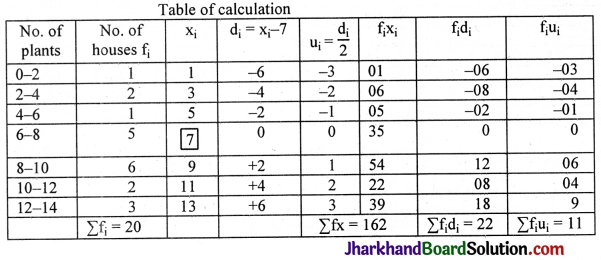
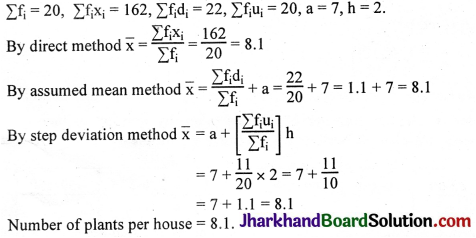
![]()




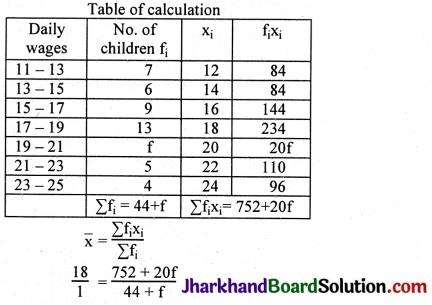
![]()

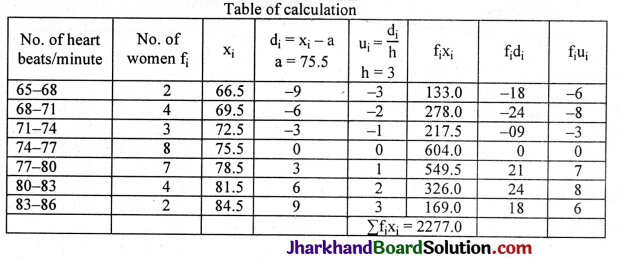


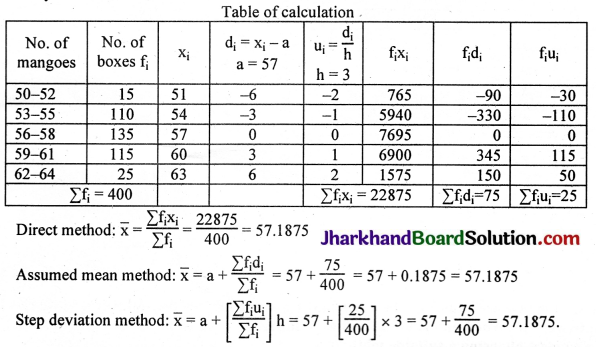



![]()


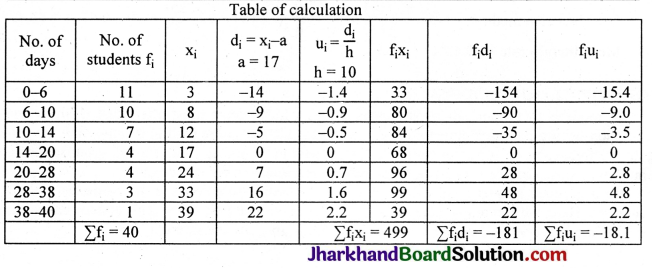
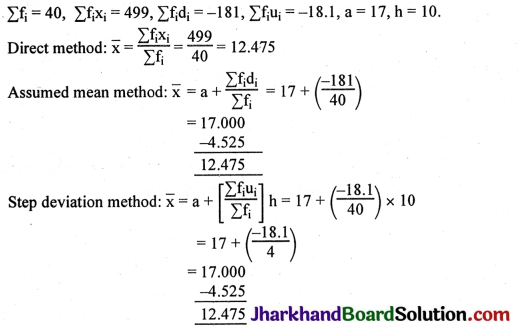
![]()

